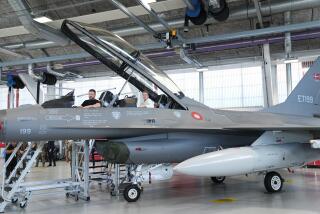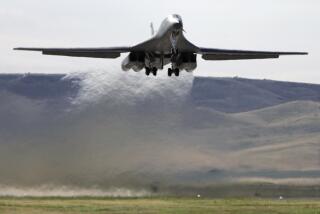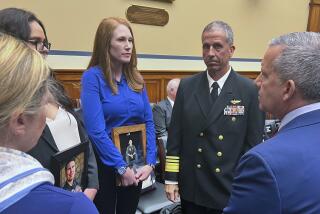Flying Off Course
SOUTH POMFRET, Vt. — If only we’d had the F/A-22 Raptor jet on the morning of Sept. 11. The ultra-fast stealth aircraft could have intercepted and shot down the second airliner heading for the south tower of the World Trade Center in New York City--and possibly those that crashed into the Pentagon and in Pennsylvania as well.
This claim--complete with the computer modeling to back it up--has been circulating in hushed whispers inside the Air Force recently, along with news that the Air Force’s new fighter, scheduled for deployment in the next five years, is being recast as an essential part of any missile defense of the United States. On Sept. 17, Air Force Chief of Staff Gen. John P. Jumper announced that the service was redesignating the airplane formerly known as the F-22 for a multimission role, thrusting its premier fighter program into a prominent position in maintaining homeland security.
Given the number of detractors the $100-million-a-plane Lockheed Martin superjet has attracted over the years--most of them outside the Air Force--the announcement smacks of opportunism. With the first Raptor planes now in flight testing, how better to solidify support from the administration, Congress and the citizenry than to promise that they will protect us on the home front?
But this is a severe case of war planners fighting the last war. Yes, maybe if the Raptor had been operational we could have saved some lives last year. But describing the new airplane as being able to do everything but deliver babies is a bit much. And if the larger goal is to prevent terrorism, is spending billions of dollars to be able to shoot planes out of the sky really the best use of resources?
The Air Force is right about one thing: The F-15 Eagle interceptors that took off at 8:52 a.m. on Sept. 11, 2001, just six minutes after American Airlines Flight 11 crashed into the World Trade Center’s north tower, weren’t able to prevent the next tragedy. According to a riveting account of the day that appeared in Aviation Week & Space Technology, the pilots of the F-15s got into the air with remarkable speed and then “jammed the ... throttles into afterburner, [devouring] the 153 miles to New York City at supersonic speeds.” But even flying supersonically, the F-15s were still eight minutes from Manhattan when the second plane, United Airlines Flight 175, smashed into the south tower.
Heartbroken and short on fuel as a result of the extended flight in afterburner, the F-15 crews refueled over the city and spent the next five hours intercepting and identifying nearly everything in the skies in the area.
Without question the F/A-22 Raptor is a faster airplane and might have gotten to New York more quickly. But what then? Would blasting an airliner full of people out of the air over a major metropolitan area have saved lives or caused more casualties?
The Raptor was designed for war. As a recent Air Force report to the secretary of Defense put it, the aircraft’s “combination of stealth, supercruise, [and] maneuverability ... represent an exponential leap in warfighting capabilities and allow for the full realization of operational concepts that are vital to the 21st century Air Force.” The plane “can exploit its stealth and speed,” the report continued, to destroy targets in the air and on the ground. It would also “significantly improve the U.S. ability to engage cruise missiles ... and achieve air superiority with much fewer platforms.” The plane’s ability to “supercruise”--to fly supersonically without going into afterburner--will allow it to travel faster, save enormous amounts of fuel and extend its range. All very useful, no doubt, but how do these bells and whistles benefit domestic security?
By enabling us to achieve more with less, the Air Force Assn., a civilian advocacy group, says. Because of their increased speed, F/A-22s could cover the air space above U.S. nuclear power plants in an emergency with half the number of F-15s it now takes.
The Air Force realizes, though, that it is treading on potentially dangerous ground. On the one hand, Americans might back increased spending on Raptor aircraft if they believed the planes could be useful in intercepting Sept. 11-type attacks. But while Air Force personnel speculate among themselves about how F/A-22s could have changed things, they don’t speculate publicly. As one senior Air Force officer says, the plane’s detractors might “misinterpret” such comments and assume that “the Air Force is trying to use the tragic events of 9/11 to support buying more F-22s.”
Air Force personnel are reluctant to give ammunition to those they believe, as the senior officer puts it, “have turned killing the F-22 into a religion.” And they have a point. Although the Air Force has believed in the plane from the beginning, outsiders were more skeptical, and the plane has traveled a rough road.
The Raptor was conceived during the Cold War, with plans to build 750. When the Soviet Union collapsed, that number was scaled back sharply. The Gulf War precipitated a second look at the craft’s mission. War planners began to realize that the U.S. had plenty of capacity to shoot enemy planes from the skies: What it really needed was more precision bombers. And so a bomb-dropping capability was added to the F-22’s functions.
Still, by the time the second President Bush came into office, Raptor supporters were barely holding together a consensus that 339 F/A-22s should be built. In May, Defense Secretary Donald H. Rumsfeld’s staff posited that perhaps the nation could make do with just 180.
Now, whether because of well-placed whispers about the plane’s role in domestic security or for some other reason, the Air Force seems to have convinced civilian military planners, including those in the Department of Defense, that the right number of Raptors is 381. Of the planes, 24 would be assigned to each of 10 so-called air expeditionary forces, the new Air Force organizational unit. The remainder will be used for training and spares. But the 381 number does not officially include planes for defense here at home, which has raised suspicions that Raptor boosters are capitalizing on fears about domestic security to secure a commitment to build even more F/A-22s.
Homeland security is red hot these days, so it’s no wonder that the military sees it as a possible way to get pet projects fully funded. Nor is it a surprise that the Air Force sees airplanes as essential to protecting the populace. But there is much harder work that needs doing--such as improving intelligence and keeping hijackers off planes in the first place. A force of 10,000 Raptors can’t accomplish that.
More to Read
Inside the business of entertainment
The Wide Shot brings you news, analysis and insights on everything from streaming wars to production — and what it all means for the future.
You may occasionally receive promotional content from the Los Angeles Times.










